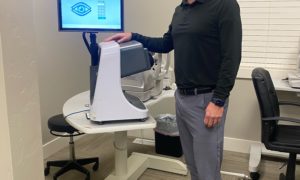 Computer vision syndrome is not the way many of your patients would describe the issues they experience after use of digital media, according The Vision Council VisionWatch Digital Eye Fatigue report. Thirty-five percent of respondents preferred the term “computer eye fatigue.” Those using digital media primarily for work selected this option more frequently, as did 45-54-year-olds. It was chosen less frequently by 18-34-year-olds and those not using vision correction. Thirty-one percent said they prefer the term “computer eye strain,” with women selecting this option more frequently than men. Nineteen percent preferred the term “digital eye fatigue” or “digital eye strain.” These options were chosen more frequently by 18-34-year-olds and school-related digital users.
Computer vision syndrome is not the way many of your patients would describe the issues they experience after use of digital media, according The Vision Council VisionWatch Digital Eye Fatigue report. Thirty-five percent of respondents preferred the term “computer eye fatigue.” Those using digital media primarily for work selected this option more frequently, as did 45-54-year-olds. It was chosen less frequently by 18-34-year-olds and those not using vision correction. Thirty-one percent said they prefer the term “computer eye strain,” with women selecting this option more frequently than men. Nineteen percent preferred the term “digital eye fatigue” or “digital eye strain.” These options were chosen more frequently by 18-34-year-olds and school-related digital users.
Average Total Screen Time is a preferred way to give insight into how people are functioning on a day-to-day basis and may be at risk for near point visual stress. Average Total Screen Time includes time spent looking at computer screens, laptops, tablets, smart phones and any other digital device that requires near vision.
On any given day, a person may spend more time viewing the smart phone screen than a computer screen, but then the next day spend more time on a computer screen than a smart phone. The Average Total Screen Time for all screens tends to be very similar, therefore, when questioning patients, it is important to consider all screens when trying to understand how the visual system is being used.
Since our eyes are primarily built for distance activities, when we force them to be used up close–especially for extended periods of time–it is not unusual for patients to complain about eye fatigue, headaches, eye strain and other related near complaints. Understanding the Average Total Screen Time helps identify at risk patients. This identification leads perfectly to a discussion of approaches (eg: specialized lenses) that can be helpful in making near visual activities more tolerable.
Computer vision syndrome may not be the best way to describe the problem to a symptomatic patient who is spending the majority of their time on a smart phone. Is near point visual stress too clinical and not descriptive enough? Do we need new terminology? To communicate the best to patients, the answer is yes.
Your action plan for this week is to review:
1. How you identify patients who are at risk for near point visual stress.
2. How you treat patients who complaining about near point visual stress.
3. How you communicate near point visual stress diagnosis and treatment.



























